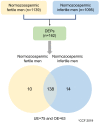Sperm Proteome Analysis and Identification of Fertility-Associated Biomarkers in Unexplained Male Infertility
- PMID: 31336797
- PMCID: PMC6678187
- DOI: 10.3390/genes10070522
Sperm Proteome Analysis and Identification of Fertility-Associated Biomarkers in Unexplained Male Infertility
Abstract
Up to 30% of men with normal semen parameters suffer from infertility and the reason for this is unknown. Altered expression of sperm proteins may be a major cause of infertility in these men. Proteomic profiling was performed on pooled semen samples from eight normozoospermic fertile men and nine normozoospermic infertile men using LC-MS/MS. Furthermore, key differentially expressed proteins (DEPs) related to the fertilization process were selected for validation using Western blotting. A total of 1139 and 1095 proteins were identified in normozoospermic fertile and infertile men, respectively. Of these, 162 proteins were identified as DEPs. The canonical pathway related to free radical scavenging was enriched with upregulated DEPs in normozoospermic infertile men. The proteins associated with reproductive system development and function, and the ubiquitination pathway were underexpressed in normozoospermic infertile men. Western blot analysis revealed the overexpression of annexin A2 (ANXA2) (2.03 fold change; P = 0.0243), and underexpression of sperm surface protein Sp17 (SPA17) (0.37 fold change; P = 0.0205) and serine protease inhibitor (SERPINA5) (0.32 fold change; P = 0.0073) in men with unexplained male infertility (UMI). The global proteomic profile of normozoospermic infertile men is different from that of normozoospermic fertile men. Our data suggests that SPA17, ANXA2, and SERPINA5 may potentially serve as non-invasive protein biomarkers associated with the fertilization process of the spermatozoa in UMI.
Keywords: biomarkers; male infertility; normozoospermic infertile men; sperm proteomics; unexplained male infertility.
Conflict of interest statement
The authors declare no conflicts of interest.
Figures





Similar articles
-
Towards the identification of reliable sperm biomarkers for male infertility: A sperm proteomic approach.Andrologia. 2018 Apr;50(3). doi: 10.1111/and.12919. Epub 2017 Dec 4. Andrologia. 2018. PMID: 29205438
-
Altered Molecular Pathways in the Proteome of Cryopreserved Sperm in Testicular Cancer Patients before Treatment.Int J Mol Sci. 2019 Feb 5;20(3):677. doi: 10.3390/ijms20030677. Int J Mol Sci. 2019. PMID: 30764484 Free PMC article.
-
Investigation of male infertility using quantitative comparative proteomics.J Proteome Res. 2014 Dec 5;13(12):5403-14. doi: 10.1021/pr501031x. Epub 2014 Nov 10. J Proteome Res. 2014. PMID: 25355644
-
Proteomics, oxidative stress and male infertility.Reprod Biomed Online. 2014 Jul;29(1):32-58. doi: 10.1016/j.rbmo.2014.02.013. Epub 2014 Mar 13. Reprod Biomed Online. 2014. PMID: 24813754 Review.
-
Proteomic Analyses of Human Sperm Cells: Understanding the Role of Proteins and Molecular Pathways Affecting Male Reproductive Health.Int J Mol Sci. 2020 Feb 27;21(5):1621. doi: 10.3390/ijms21051621. Int J Mol Sci. 2020. PMID: 32120839 Free PMC article. Review.
Cited by
-
Implementing a preimplantation proteomic approach to advance assisted reproduction technologies in the framework of predictive, preventive, and personalized medicine.EPMA J. 2022 May 21;13(2):237-260. doi: 10.1007/s13167-022-00282-5. eCollection 2022 Jun. EPMA J. 2022. PMID: 35719135 Free PMC article. Review.
-
Mitochondrial dysfunction signatures in idiopathic primary male infertility: a validated proteomics-based diagnostic approach.Front Reprod Health. 2024 Dec 12;6:1479568. doi: 10.3389/frph.2024.1479568. eCollection 2024. Front Reprod Health. 2024. PMID: 39726694 Free PMC article.
-
Role of genetic variations and protein expression of β-Microsemino protein in intrauterine insemination outcome of unexplained infertile men: A case-control study.Int J Reprod Biomed. 2024 Aug 5;22(6):481-494. doi: 10.18502/ijrm.v22i6.16799. eCollection 2024 Jun. Int J Reprod Biomed. 2024. PMID: 39205920 Free PMC article.
-
Biomarker-based human and animal sperm phenotyping: the good, the bad and the ugly†.Biol Reprod. 2024 Jun 12;110(6):1135-1156. doi: 10.1093/biolre/ioae061. Biol Reprod. 2024. PMID: 38640912 Free PMC article. Review.
-
GlycoIP: an integrated platform for simultaneous and site-specific N/O-glycosylation analysis of human semen.Front Chem. 2025 May 19;13:1569561. doi: 10.3389/fchem.2025.1569561. eCollection 2025. Front Chem. 2025. PMID: 40458655 Free PMC article.
References
-
- Nieschlag S. Andrology: Male Reproductive Health and Dysfunction. Springer Science & Business Media; Berlin/Heidelberg, Germany: 2013.
-
- Hamada A., Esteves S.C., Agarwal A. Unexplained male infertility: Potential causes and management. Hum. Androl. 2011;1:2–16. doi: 10.1097/01.XHA.0000397686.82729.09. - DOI
-
- Doshi S.B., Sharma R.K., Agarwal A. Oxidative stress in unexplained male infertility. In: Schattman G.L., Esteves S.C., Agarwal A., editors. Unexplained Infertility: Pathophysiology, Evaluation and Treatment. Springer; New York, NY, USA: 2015. pp. 81–89.
-
- World Health Organization . WHO Laboratory Manual for the Examination and Processing of Human Semen. WHO; Geneva, Switzerland: 2010.
Publication types
MeSH terms
Substances
LinkOut - more resources
Full Text Sources
Other Literature Sources
Medical
Miscellaneous

